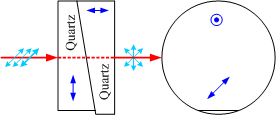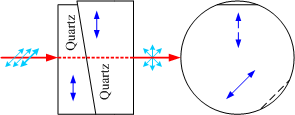|
|
Current location: Polarizer
|
Plane polarized beam is not welcomed in some circumstances such as reflecting spectrometer. A depolarizer will change the plane polarization into a mix of polarization states by scrambling up the polarization, the result is to change plane polarized beam into pseudo-depolarized beam and produce depolarization. Depolarizer is widely used in polarization sensitive instrument
Quartz wedge depolarizer
JGI's quartz wedge depolarizer consists of two 3deg wedges of crystal quartz. Usual wedge depolarizer consists of one crystal quartz wedge and a compensation fused silica to avoid big beam deviation, but the deviation is also very big for some precise instruments. JGI does not use fused silica plate to compensate the beam deviation, we use a crystal quartz plate with its optical axis along the propagation direction. Because the depolarizer is constructed by same material, so the beam deviation can be much better. The usual depolarizer can only be used at narrow band wavelength to avoid the big beam deviation. With our special design, our depolarizer can be used in a wide range of wavelength and keep the beam deviation in an acceptable range.
When a beam hits on the depolarizer, there is a variable phase shift across the beam aperture on the wedge, so a polarized beam can be effectively depolarized. Quartz wedge depolarizer can work well with monochromatic and broadband light source.Usually we can get better result if we orient the input polarization state 45deg to the optical axis of the depolarizer. And also the effectiveness of the depolarizer increases with the size of the beam cross-section. |
| |
- Better At 45deg Optical Axis Alignment
- Ideal for >6mm Diameter Monochromatic Light & Broadband Light
- Epoxy Cemented or Optically Contacted Available

|
| |
| Specifications |
| |
| Material |
Quartz+Quartz |
| Dimension Tolerance |
+0/-0.2mm |
| Thickness Tolerance |
±0.2mm |
| Surface Quality |
60/40 |
| Parallelism |
<1 arc minute |
| Beam Deviation |
<3 arc minutes |
| Flatness |
λ/8@632.8nm |
| Retardation |
0.5λ/mm at 1064nm |
| Clear Aperture |
>90% central |
| Coating |
Uncoated |
| Damage Threshold |
Cemented: >500mJ/cm2, 20ns, 20Hz @1064nm
Optically contacted: >5J/cm2, 20ns, 20Hz @1064nm |
quartz Lyot depolarizer
| Plane polarized beam is not welcomed in some circumstances such as reflecting spectrometer. A depolarizer will change the plane polarization into a mix of polarization states by scrambling up the polarization, the result is to change plane polarized beam into pseudo-depolarized beam and produce depolarization. Depolarizer is widely used in polarization sensitive instrument.
JGI'S quartz Lyot depolarizer converts a polarized beam into a pseudo-random polarized beam. Regarding Linearly polarized beam from a monochromatic source, the output beam is converted to pseudo-depolarized beam with polarization state varies spatially. Linearly polarized beam comes from a broadband source which is transmitted through a quartz Lyot depolarizer will have a polarization that varies spatially as well as with wavelength.JGI's quartz Lyot depolarizer consists of two crystal quartz wedges, the thickness of one is twice of the other. The optical axis of each wedge is in the plane of aperture, the orientation angle between two optical axes is 45°. The unique design of the quartz Lyot depolarizer does not require orienting the optical axes of a depolarizer at a specific angle, which is especially useful where the initial polarization state of the light is unknown or varies with time.
Regarding monochromatic light, we can only get good pseudo-random polarization when the input diameter is bigger than 6mm. The minimum beam diameter requirement comes from that randomization of the output beam's polarization is achieved by producing a spatial variation when the light hits on the wedge surface. Regarding a broadband source, it does not have the same beam diameter restriction because of the wavelength dependent retardation and also spatial variation. |
| |
- No Requirement Of Optical Axis Alignment
- Ideal for >6mm Diameter Monochromatic Light & Broadband Light
- Epoxy Cemented or Optically Contacted Available

|
| |
| Specifications |
| |
| Material |
Quartz+Quartz |
| Dimension Tolerance |
+0/-0.2mm |
| Thickness Tolerance |
±0.2mm |
| Surface Quality |
60/40 |
| Parallelism |
<1 arc minute |
| Beam Deviation |
<3 arc minutes |
| Flatness |
λ/8@632.8nm |
| Clear Aperture |
>90% central |
| Coating |
Uncoated |
| Damage Threshold |
Cemented: >500mJ/cm2, 20ns, 20Hz @1064nm
Optically contacted: >5J/cm2, 20ns, 20Hz @1064nm | | | |
|



